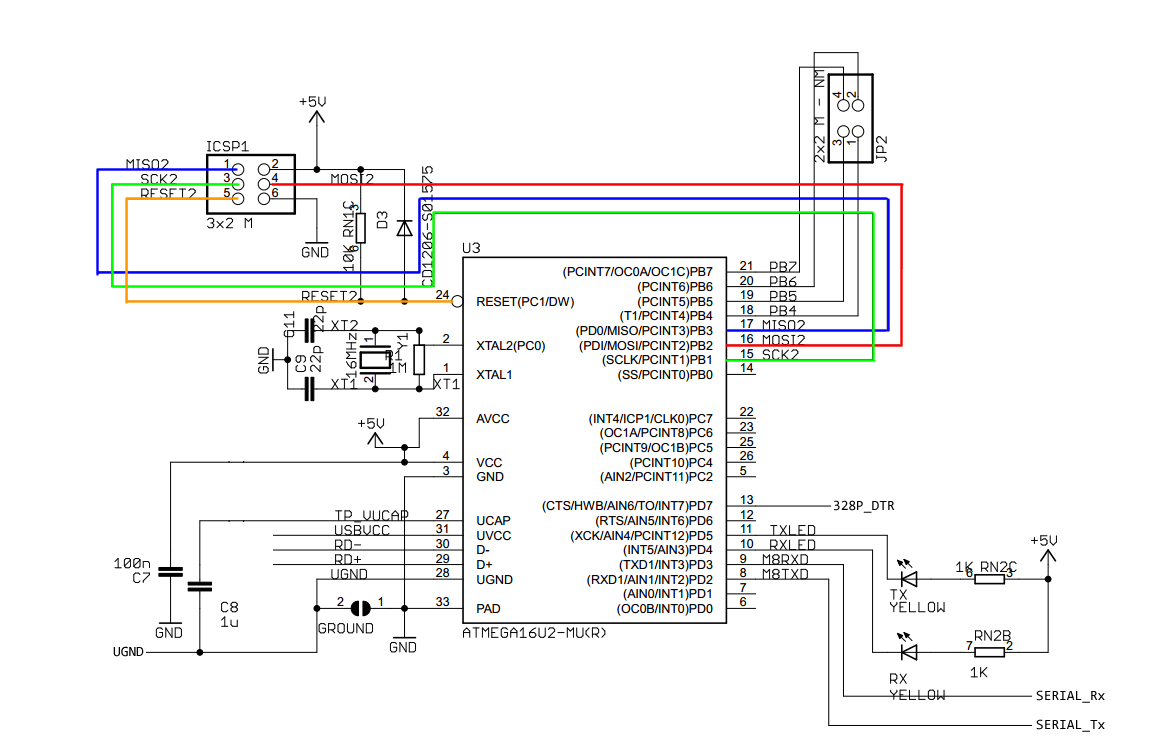

- #UNO R3 SCHEMATIC SERIAL#
- #UNO R3 SCHEMATIC FULL SIZE#
- #UNO R3 SCHEMATIC CODE#
- #UNO R3 SCHEMATIC SERIES#
The datasheet (page 4) says you should connect AVcc to Vcc through a low pass filter, which helps to stabilize all the analog stuff the micro might do. AVcc is the connection that allows you to deliver voltage to the analog portions of the 16U2, like the Analog-to-digital converters (ADCs). Vcc is the connection that allows you to deliver voltage to the digital portions of the 16U2, like the digital GPIO ports. I picked a Harwin M20-9980346.Īfter writing it all out, I decided the crystal selection process was so in-depth it required its own part of the series: Arduino From Scratch Part 9: 16Mhz Crystal Oscillator The actual physical header is just a really, really standard 0.1″ two row, six pin connector header. 1N414BW-7-F spike protection diode, simply because there were more of them in stock at distributors than there were for the Bournes part listed on the schematic CD1206-S01575, and the Diode’s Inc. As near as I can tell, it’s actually only a (potential) problem with the 328P, but it doesn’t really affect the circuit negatively, so they just duplicated that portion of the circuit onto the 16U2 as well.įor parts, I reused the same 10K resistor from the comparator subsystem voltage divider, and picked a Diodes Inc. In this case, it exists to prevent possible voltage spikes occurring on the RESET pin due to some exotic issue identified in the Arduino forums. It’s not common to find it on an ICSP header circuit, or if there is a diode, it’s used to prevent the programmer from inadvertently powering your project. The only thing left over to explain is the diode.
#UNO R3 SCHEMATIC CODE#
All of these pins are used in a specific sequence to set the micro into a specific programming state, then load code into it through the programmer. The 10K resistor (RN1C) is there to act as a pull up resistor to 5V, creating a default “Not Reset” state for the pin. Reset is active low (which I denote here by using the overline macron, but on the Arduino schematic is shown by the circle at the base of the pin), so if and when the 16U2 detects that pin at a logical low state, it will process a system reset.

Further, there’s a 5V connection, Ground and RESET. That’s where the “Serial” part of the ICSP comes in. You can see that we’re using the SCK / MISO / MOSI lines off the 16U2, the SPI pins. We’ll cover the way we actually use the header in the future, but right now, let’s look at the circuit.
#UNO R3 SCHEMATIC SERIAL#
The In-Circuit Serial Programmer is the method that we will use to load firmware into our 16U2, using some form of AVR Programmer, since I sure don’t have a TQFN programming socket sitting around for these things. We’ll start at the ICSP header and work our way counter clockwise (anticlockwise for all my English readers out there). That’s a *lot* of capability just sitting there not just un-used and un-utilized, but effectively abandoned in place with no ability to access it.Īs we’ve done in each part so far of the series, let’s take it step by step.

Interestingly, the right side of the schematic shows that there are a ton of pins that are absolutely and completely ignored.

The right side has … well … whateverthehell JP2 is, the Data-Terminal-Read (DTR) line, some LEDs that flash when serial transactions occur, and the actual serial Tx/Rx connections to the 328P. The official schematic has connections on the left to the USB stuff, a crystal oscillator circuit, the supply voltages, and the In-Circuit Serial Programmer (ICSP) header.
#UNO R3 SCHEMATIC SERIES#
I’ve also tried to remove anything from the official schematic that is either already covered (USB, etc) or will be covered in future parts of the series (328P_DTR), so the schematic is a little different than the officially official one published, but we’ve already covered my problems with the published documentation.
#UNO R3 SCHEMATIC FULL SIZE#
Make sure to click on it to expand it or download the full size so you can see it clearly. Now, in both cases, the official schematic and the KiCad schematic below, this subsystem grows to a size that is a little unwieldy to display on a web page, so I’ve shrunk it down to a semi thumbnail size. This is the chip responsible for converting USB signals into the bits that can be read by the serial Tx and Rx pins (the UART pins) of the bigger brother micro, the ATMEGA328P.īuild An Arduino UNO R3 from Scratch Table of ContentsĪ Cleaned Up Official ATMEGA16U2 Schematic Now we introduce that micro, the Atmel ATMEGA16U2. In Part 7, we pulled together all the parts necessary to connect our USB Type B socket to a microcontroller.


 0 kommentar(er)
0 kommentar(er)
